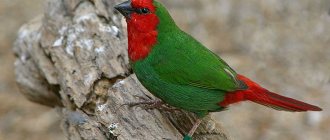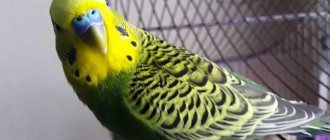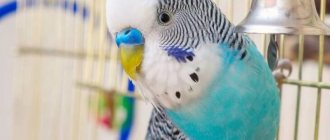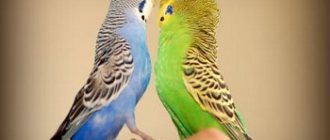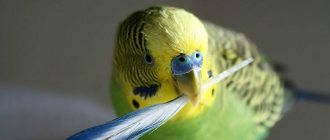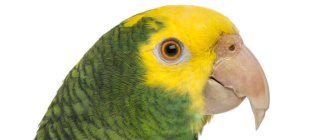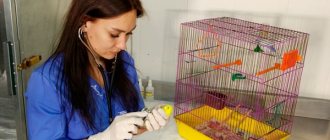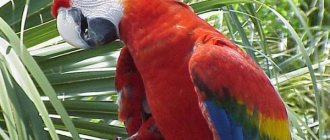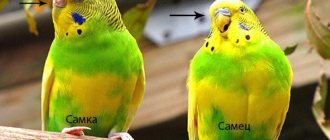Although budgerigars are hardy birds, they do not tolerate fluctuations in environmental temperatures. The task of the owners of such birds is to create comfortable conditions for them, because their health and even life depend on this. Let's find out at what temperatures birds feel good, and what to do if the parrot is overheated or cold.
What should the home climate be like for a bird?
A good half of exotic birds live in the subtropical climate zone: Australia, Africa, South America, etc.
Accordingly, the microclimate of the room where the parrot is located must be adjusted to these latitudes. It is especially important to create a suitable microclimate in the northern regions of Russia .
For example, in the autumn in the Arkhangelsk or Irkutsk regions, local residents more or less tolerate low temperatures in their apartments when heating is not yet provided. Whereas a bird can react very sharply to the lack of heat.
A similar situation is observed with humidity levels. In arid steppe areas, indicators are significantly underestimated, so the bird will be in constant discomfort. Whereas in regions with rivers and lakes the level is close to normal.
When organizing the microclimate in the room, you should take into account the specifics of the breed and size of the birds. For example, large individuals such as macaws, cockatoos or Amazons can more easily tolerate short-term drops in temperature, unlike lovebirds or budgies.
Temperature
The optimal temperature for most members of the parrot family is from 22 to 25°C. If the thermometer drops below 18°C, then it is urgently necessary to organize additional heating using specialized equipment.
An ideal option for city apartments is an oil heater . When the low temperature stays in the room for more than 6-7 months, then it makes sense to look towards lamps. They consume much less electricity and do not dry out the air, unlike oil-based equipment.
Heaters should not be placed too close to the cage. Also, there should be no drafts in the room. Parrots get cold easily due to sudden temperature changes.
Humidity
For medium and large exotic birds, the usual humidity level fluctuates around 75-85%. Small individuals are more resistant to low rates. For them, the norm can be reduced to 60%. The problem of low humidity levels is easily solved with humidifiers.
Fountains, soaked towels, saucers of water and other folk methods will not help here or will only work partly. The parrot needs stable humidity levels, while the latter will provide a highly fluctuating percentage.
Domestic solutions are enviably popular. Russian air humidifiers can boast of both their efficiency and a very affordable price tag. Decent models can be found for 2-3 thousand rubles in the range of Ecostar or ZDK brands.
Light
In the spring and summer months, there are usually no problems with natural light. The bird will feel comfortable with 12 hours of daylight. Therefore, with the onset of late autumn, you should take care of artificial lighting.
The critical point here is low-frequency ultraviolet. It is he who acts as a catalyst in the synthesis of many vitamins in the animal’s body. Its effect also has a beneficial effect on the formation of bone and cartilage tissue.
To organize a sufficient amount of low-frequency ultraviolet radiation in the cold season, special lamps with temperatures from 5000 to 7000 K and color indicators in the region of 90 CRI are suitable. They should be placed at a distance of 20-35 cm from the cage, but not close at all, otherwise the bird may damage the equipment and injure itself.
Many breeders recommend the well-proven Philips brand model - TL950. You can also find specialized solutions from the OSRAM, Sylvania and Arcadia brands.
When purchasing equipment, you should take into account that ordinary fluorescent lamps are not suitable for birds and even harm them. The fact is that conventional models create a stroboscopic effect due to the low frequency of alternating current. When the device is close, the bird perceives the lighting as a continuous series of flashes.
Artificial heat sources
If sick, your parrot's body temperature may drop. To keep your pet warm and warm, use:
- special lamp;
- oil heater;
- ordinary incandescent light bulb up to 60W.
Heating must be carried out while the pet is awake from 2 to 4 hours a day. It is advisable that the lamps be green or blue, so the bright light will not disturb the bird.
Consequences of an unsuitable microclimate
Low temperatures provoke colds and related complications. Overheating is also undesirable for birds. The heat disrupts the functioning of the endocrine system, which leads to disruptions in the production of hormones, and at the same time, the condition of the feather cover and the well-being of the parrot as a whole worsens.
Too high or low humidity levels affect metabolism. As a result, immunity decreases. A clear sign of moisture problems is your pet's difficulty breathing along with a lethargic state.
We must not forget about clean air . Parrots are extremely susceptible to tobacco smoke, deodorants and other fumes. Therefore, a bathroom with a kitchen is not the best place for a cage.
Lack of ultraviolet radiation also negatively affects the bird’s body.:
- metabolic processes slow down;
- the level of red blood cells decreases;
- hemoglobin increases;
- the bactericidal qualities of blood decrease;
- the volume of phosphorus and potassium decreases;
- immunity decreases.
It is also useful to read: For what reasons do parrots die?
You should not overuse sunbathing. An excess of ultraviolet radiation is just as bad as a lack of it. There should be a place in the cage where the parrot can hide from direct sunlight. Otherwise the bird will be stressed.
Body temperature of budgerigars
The normal body temperature of these birds is +41°C. The bird regulates it by controlling activity or changing the level of metabolic processes. If an animal is cold, the temperature drops faster than it rises when it is hot. Therefore, you need to try to maintain a comfortable temperature in the room and regularly monitor the bird’s body temperature.
How to dry
Even if your budgie is very wet, there is no need to try to dry it with a towel or blow dry it. Drying should be natural. The most the owner can do is put the wavy in a cage and place it closer to the battery. Or turn on an incandescent lamp (40 W) and point it at the cage in which the wet parrot is sitting.
After bathing, the bird will crest for a while because it will be a little cool. Do not disturb your budgie and allow him to dry completely first and then begin playing and enjoying his favorite pastime with your pet.
When should you seek emergency medical help?
It is necessary to call a doctor or ambulance in the following cases:
- The child is less than 3 months old and has a temperature of 38°C or higher
- The baby is between 3 and 6 months old and has a temperature of 39°C or higher
- Against the background of fever, rash, vomiting, and diarrhea appeared
- Fever lasts for 5 days or more
- The child refuses the breast, does not eat, behaves unnaturally
- The child has signs of dehydration: dry diapers, sunken eyes, crying without tears.
Still have questions?
Get an online consultation from leading pediatricians in St. Petersburg!
A professional and experienced pediatrician will answer your questions.
Medical care for a child without leaving home at a convenient time.
sign up for a consultation
A Skype consultation lasts 45 minutes.
Where to put the bath
It is better that bathing takes place outside the cage, otherwise the parrot will spoil the food with its splashes. The bath should be placed in a lighted and draft-free place, placing it on a towel. This will prevent puddles around and at the same time partially dry the bird that has made it to the shore.
Be sure to supervise your budgie when it bathes. Firstly, this is important for its safety, because an inexperienced wavy may wet its wings too much and try to take off. In this case, he will fall and hurt himself. Secondly, watching a parrot splashing and squeaking with pleasure is very interesting.
If the parrot gets dirty
This happens: a wavy fell into a rosette with jam, got smeared in the Velcro coating for flies, or got dirty in some other way. If the parrot is heavily soiled, you will have to bathe it, otherwise its feathers may stick together and impair its flight ability. And if you try to clean yourself, the wavy can get poisoned (especially if it gets dirty in something inedible).
Washing should begin with bathing the wavy itself. Let him splash to his heart's content first, and only then can you help him. If the stain cannot be washed off with water, you can use baby shampoo or fragrance-free baby soap. Lather your palm and run it over the parrot's feathers. There is no need to ruffle them, because the bird rarely gets dirty to the skin. It is enough to wash off the top layer of dirt.
We recommend reading: Why do budgies sneeze?
After lathering the wavy, take it in your hands and rinse it under a slow running stream of warm water. Strong pressure will scare the bird or even hurt it, so be careful. When you are sure that there is no more dirt or soap on the feathers, release the parrot into a bath with clean water. Let him finally wash everything off himself.
Light mode
A twelve-hour day is suitable for budgies to stay awake. This is achieved using a variety of lamps. But remember, sunlight is still necessary for the production of vitamin D. Therefore, in the summer, the cage with the pet is taken out to the balcony or veranda. At the same time, do not forget to keep an eye on the bird so that it does not get heatstroke.
Light mode for budgerigar
A few more tips
Parrots are very curious and active birds, which, when flying out of the cage, can suffer from the dangers that lie in wait for them in our house very often. Therefore, if you are planning to let your pet out of the cage so that he can stretch his wings a little, then you should know what you need to pay attention to so that the first flight does not end in tragedy. When you release a parrot, make sure that the vents, windows, and balcony doors are closed. Otherwise, you risk never seeing your feathered friend again. Glass doors and mirrors in the apartment also pose a serious danger. A parrot may be seriously injured without noticing an obstacle.
Various openings to which we usually do not pay attention can be fraught with danger for a curious bird. Make sure that the parrot cannot get into the room where there are ventilation grilles, do not leave pots open in the kitchen, close trash cans, do not scatter markers, felt-tip pens around the apartment, and in no case use insect repellents where they the parrot may be poisoned.
If, in addition to the parrot, other animals live in your house, then try to protect the bird as much as possible from their attack. For example, a peace-loving and good-natured cat may well be the last thing your parrot sees in his life. If you are making repairs, it is better to give the cage with the parrot to your family or friends for a while. Volatile chemical compounds released by varnishes, paints, adhesives, sealants and some building materials can be deadly to a parrot. In addition, for the apartment where the parrot lives, you should especially carefully choose indoor plants, since many of them are very poisonous to the parrot. Plants that are dangerous for your feathered pet include amaryllis, dieffenbachia, monstera, ivy, narcissus, lily, aloe, violets, ferns, and gardenia. As you can see, keeping a budgerigar is not such a simple matter, requiring your constant attention and care for your pet, but it is rewarded a hundredfold with the cheerful chirping of these beautiful and cheerful birds, adding positive emotions to our lives with their cheerful behavior. And believe me, it’s worth it!
- Persian cats: grooming, nutrition and care.
- How to keep a ferret at home?
- The most caring mothers of the animal world.
- How to choose a dog?
>>>


